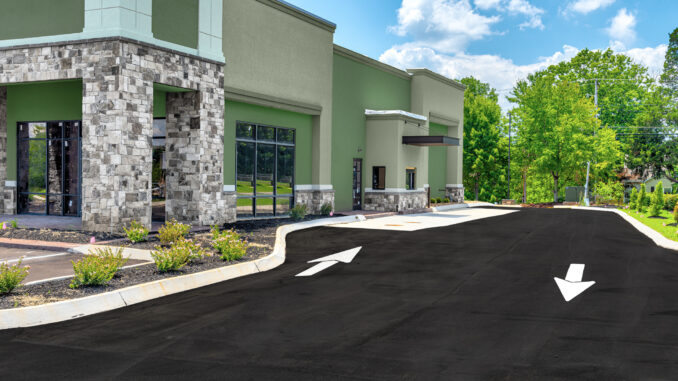
By Mo Chaar, Chief Commercial Officer, Givex - 7.18.2024
The restaurant industry — like many other industries — is experiencing significant challenges in securing prime real estate for new locations. Factors such as limited availability of ideal sites, high rental costs and fierce competition among brands have made it increasingly difficult for franchisors to expand their footprint effectively. However, integrating advanced technology solutions into operations can help mitigate these real estate woes by optimizing space usage and enhancing operational efficiency both in the front-of-house (FOH) and back-of-house (BOH).
JLL reported that 68% of restaurant deals in the first quarter of 2024 were for spaces under 2,500 square feet, for example, highlighting a trend towards smaller footprints due to technological efficiencies. Here’s a deeper dive into how restaurant operators can leverage technology to overcome today’s real estate challenges.
The State of the Commercial Real Estate Market
The commercial real estate market has seen a substantial increase in demand for retail properties over the past 18 months. With approximately 35 million square feet of new retail space developed across the U.S., the competition for prime locations has intensified. This surge in demand has led to higher rental costs, making it challenging for many restaurant operators to secure affordable, high-quality locations. In Houston, for example, the commercial vacancy rate is only 4%. This scarcity has driven up occupancy costs, which now exceed the normal 10% occupancy cost of pre-pandemic levels.
Higher interest rates are also contributing to overall inflation, which raises the costs of construction materials and labor. This, combined with increased rent, results in even higher operational costs for restaurants.
A report by Deloitte highlights that nearly half of the respondents expect the cost of capital and capital availability to worsen through 2024, up from 38% and 40%, respectively, from the previous year. This further complicates the financial landscape for securing new properties.
Maximizing Space Efficiency with Technology
The persistent struggle to find suitable real estate has prompted many franchisors to rethink their operational strategies. One of the key approaches is minimizing the physical footprint required for each location. This can be achieved through several technological innovations:
- Kiosks and Self-Service Stations: Implementing kiosks reduces the need for large dining areas by speeding up service and minimizing customer wait times. These self-service options can handle ordering and payment processes efficiently, allowing for a more streamlined layout. Companies like Taco Bell are leading the way by heavily learning on kiosks in its newly launched “Go Mobile” prototype, which significantly reduces the need for extensive counter space and seating areas — the average mobile store comes in at 1,325 square feet.
- Delivery and Pick-Up Areas: With the rise of online ordering, designated delivery and pick-up zones can significantly reduce the space needed for traditional dine-in services. These areas can be optimized for quick turnaround, ensuring that the operations remain efficient even with a smaller footprint. McDonald’s, for example, recently launched its new beverage-focused CosMc’s spinoff, and Burger King’s innovative suspended kitchen design allows customers to park in a designated parking spot, scan a QR code and have their food brought to their car. These trends allow restaurant operators to reduce rental costs significantly by optimizing the space they need.
- Drive-Thrus: Drive-thru services have become increasingly popular, especially in fast-casual and quick-service restaurants. By incorporating multiple drive-thru lanes and integrating them with digital menu boards and mobile app ordering, restaurant operators can serve more customers without the need for extensive indoor seating. Brands like Sweetgreen, Chick-fil-A and Shake Shack are aggressively adding drive-thrus, increasing the demand and cost for suitable properties.
- Artificial Intelligence (AI) and Automation: AI-driven systems can optimize kitchen layouts and workflows, reducing the space required for food preparation. Automation in order processing, inventory management and scheduling can also streamline operations, making it feasible to operate in smaller locations without compromising on service quality. Yum! Brands, for example, acquired the AI company Dragontail in 2021, which automates kitchen flow, driver dispatch and customer order tracking across nearly 4,000 Pizza Hut locations globally.
Enhancing FOH and BOH Efficiencies
Technology can also play a crucial role in creating efficiencies that make operations viable regardless of the restaurant’s size. Here are a few ways in which technology can enhance both FOH and BOH operations:
- POS Systems: Modern point-of-sale (POS) systems integrate various functions such as order management, payment processing and customer relationship management. These systems can provide valuable data insights, helping restaurant operators optimize their menus and service processes based on customer preferences and operational performance. And with rising real estate costs, restaurant POS data can be used to evaluate how those price increases can be offset to the customer in the best possible way.
- AI-Powered Analytics: AI can analyze customer data to predict trends and optimize inventory, reducing waste and ensuring that the right products are always available. AI can also assist in staff scheduling by predicting busy periods and adjusting shifts accordingly, enhancing labor efficiency. Yum! Brands leverages an AI-powered ordering module that informs managers of how much product to order weekly, for example.
- Digital Ordering Platforms: Integrating digital ordering platforms with kitchen display systems can streamline order flow, reducing the time between order placement and fulfillment. This integration ensures that even during peak hours, operations run smoothly without the need for additional space or staff. McDonald’s, for example, leverages easy ordering and payment ID technology to streamline transactions by recognizing customers at the display screen.
Adapting to the New Real Estate Landscape
Overall, finding quality real estate continues to be a significant challenge for restaurant operators, but technology offers some promising solutions. By adopting a tech-driven approach, restaurant operators can reduce their reliance on large physical spaces and improve their efficiency in various real estate situations, regardless of location constraints. Embracing these technological tools will be crucial for sustaining growth and remaining competitive in the ever-changing restaurant industry.
 Since joining Givex in 2007, Mo Chaar has helped the company expand its North American footprint. He began his tenure as a Business Development Manager before becoming Vice President of Sales for North America, and then moved to his current role of Chief Commercial Officer. In this role, Chaar oversees commercial strategy and development worldwide as well as managing the sales teams within North America. His experience in gift card, loyalty and POS has played a pivotal role in the success of some of Givex’s largest partners. As Givex continues to expand on a global level, with a wide array of product offerings, there is a need to keep the teams aligned on pricing, product and sales approach. As the CCO, Chaar continues to manage the North American Sales and Corporate Account Management teams and also takes on the added duties of supporting the Global Managing Directors in ensuring that all functions of the organization are aligned to meet our strategic commercial objectives.
Since joining Givex in 2007, Mo Chaar has helped the company expand its North American footprint. He began his tenure as a Business Development Manager before becoming Vice President of Sales for North America, and then moved to his current role of Chief Commercial Officer. In this role, Chaar oversees commercial strategy and development worldwide as well as managing the sales teams within North America. His experience in gift card, loyalty and POS has played a pivotal role in the success of some of Givex’s largest partners. As Givex continues to expand on a global level, with a wide array of product offerings, there is a need to keep the teams aligned on pricing, product and sales approach. As the CCO, Chaar continues to manage the North American Sales and Corporate Account Management teams and also takes on the added duties of supporting the Global Managing Directors in ensuring that all functions of the organization are aligned to meet our strategic commercial objectives.
Are you an industry thought leader with a point of view on restaurant technology that you would like to share with our readers? If so, we invite you to review our editorial guidelines and submit your article for publishing consideration.

